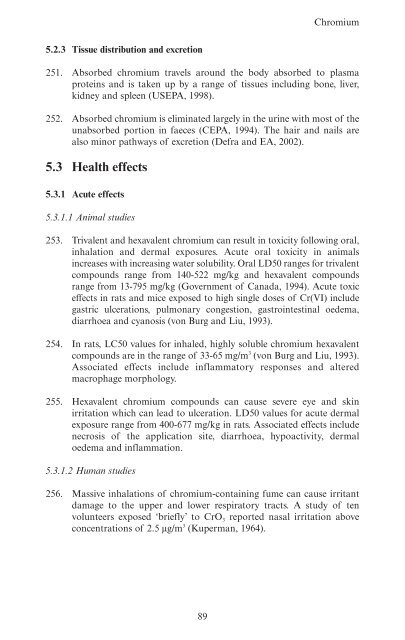Guidelines for Metals and Metalloids in Ambient ... - ARCHIVE: Defra
Guidelines for Metals and Metalloids in Ambient ... - ARCHIVE: Defra
Guidelines for Metals and Metalloids in Ambient ... - ARCHIVE: Defra
Create successful ePaper yourself
Turn your PDF publications into a flip-book with our unique Google optimized e-Paper software.
Chromium<br />
5.2.3 Tissue distribution <strong>and</strong> excretion<br />
251. Absorbed chromium travels around the body absorbed to plasma<br />
prote<strong>in</strong>s <strong>and</strong> is taken up by a range of tissues <strong>in</strong>clud<strong>in</strong>g bone, liver,<br />
kidney <strong>and</strong> spleen (USEPA, 1998).<br />
252. Absorbed chromium is elim<strong>in</strong>ated largely <strong>in</strong> the ur<strong>in</strong>e with most of the<br />
unabsorbed portion <strong>in</strong> faeces (CEPA, 1994). The hair <strong>and</strong> nails are<br />
also m<strong>in</strong>or pathways of excretion (<strong>Defra</strong> <strong>and</strong> EA, 2002).<br />
5.3 Health effects<br />
5.3.1 Acute effects<br />
5.3.1.1 Animal studies<br />
253. Trivalent <strong>and</strong> hexavalent chromium can result <strong>in</strong> toxicity follow<strong>in</strong>g oral,<br />
<strong>in</strong>halation <strong>and</strong> dermal exposures. Acute oral toxicity <strong>in</strong> animals<br />
<strong>in</strong>creases with <strong>in</strong>creas<strong>in</strong>g water solubility. Oral LD50 ranges <strong>for</strong> trivalent<br />
compounds range from 140-522 mg/kg <strong>and</strong> hexavalent compounds<br />
range from 13-795 mg/kg (Government of Canada, 1994). Acute toxic<br />
effects <strong>in</strong> rats <strong>and</strong> mice exposed to high s<strong>in</strong>gle doses of Cr(VI) <strong>in</strong>clude<br />
gastric ulcerations, pulmonary congestion, gastro<strong>in</strong>test<strong>in</strong>al oedema,<br />
diarrhoea <strong>and</strong> cyanosis (von Burg <strong>and</strong> Liu, 1993).<br />
254. In rats, LC50 values <strong>for</strong> <strong>in</strong>haled, highly soluble chromium hexavalent<br />
compounds are <strong>in</strong> the range of 33-65 mg/m 3 (von Burg <strong>and</strong> Liu, 1993).<br />
Associated effects <strong>in</strong>clude <strong>in</strong>flammatory responses <strong>and</strong> altered<br />
macrophage morphology.<br />
255. Hexavalent chromium compounds can cause severe eye <strong>and</strong> sk<strong>in</strong><br />
irritation which can lead to ulceration. LD50 values <strong>for</strong> acute dermal<br />
exposure range from 400-677 mg/kg <strong>in</strong> rats. Associated effects <strong>in</strong>clude<br />
necrosis of the application site, diarrhoea, hypoactivity, dermal<br />
oedema <strong>and</strong> <strong>in</strong>flammation.<br />
5.3.1.2 Human studies<br />
256. Massive <strong>in</strong>halations of chromium-conta<strong>in</strong><strong>in</strong>g fume can cause irritant<br />
damage to the upper <strong>and</strong> lower respiratory tracts. A study of ten<br />
volunteers exposed ‘briefly’ to CrO 3 reported nasal irritation above<br />
concentrations of 2.5 µg/m 3 (Kuperman, 1964).<br />
89
















